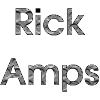 |

|

|

|

|

|

|

|
M & B Series
In 1953, F.C. Hall bought the Electro Strings Company. He had been distributor for a well-known electric instrument company from Fullerton and, as such, had been in direct contact with resellers - he knew what the consumers wanted. He adapted product lines and cleared the amplifier bazaar of the thirties and forties. Only one line of amplifiers was to remain thougout the fifties, with many variations: the M Series. This line of amplifiers was replaced during the sixties by the B Series, seemingly more of a cosmetic change than anything else; for instance, the control panel was recessed at the rear of the top on the M Series, while it was located at the front, often at an angle, on the B Series. Electronics were pushed to less conservatory boundaries, notably on the B+ voltage.
During the seventies, however, the B-410/212/115 represent a real evolution towards Twin-like 100W amplifiers.
M-8
A classic. Users still rave today about its tone. Sports two inputs an 8" Jensen speaker and a single control: a volume chickenhead knob combined with the on/off switch. It came usually in grey Tolex and a nice clear plastic handle, but was also seen with a cream cover and a leather handle. Dimensions are 13½"W x 11½"H x 5½"D. It first appeared unnamed in the '55 catalog as part of the "Student Hawaiian Guitar Set".
It had a single-ended power stage, Champ-style, when previous amps featured mostly, if not exclusively, a push-pull stage. You can find the schematic on the RIC site. A single 6V6 was driven by a 6AV6, without negative feedback. Sometimes the simplest designs are the most effective. Some (probably later) M-8s were reported to feature a more common 12AU7 in lieu of the bizarre 6AV6, however. Bizarre? Yes, because it is a duo-diode + single triode, the kind you see in old radios at the detector stage... also used in earlier Fender Harvards or in the Gibson GA-40, by the way. Here is an explanation. Who was proficient enough in electronics to design a guitar amplifier? Obviously, radio engineers. If they needed a preamp stage, they would use a tube they knew well, whose surrounding component values would only need minor tweaks to obtain a working system, and - added bonus - which was widely available.

|

|
M-88
It is already present in the 1953 catalog, seemingly an evolution of the M-8. Or is it the other way around, since the M-8 appeared only in later catalogs? It had volume and tone pots, and controls were at the top.
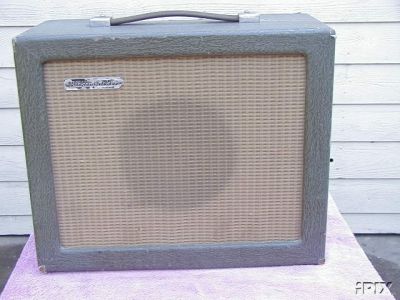
|
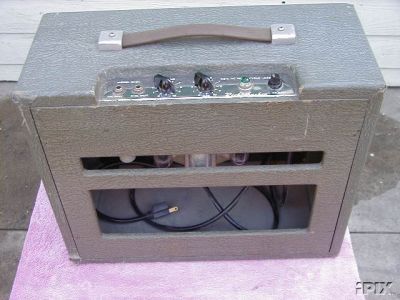
|
The model pictured above is a later version (after 1955). Below is another example of this amplifier, featuring a earlier, more rounded case. Here, the stomp switch power indicator is replaced by a stomp switch, but it is only a later alteration. Tubes: 6X5GT, 6SL7GT, 6V6GT powering a tiny Jensen speaker. A serial number was printed on the inside of the case: "K 6 113."
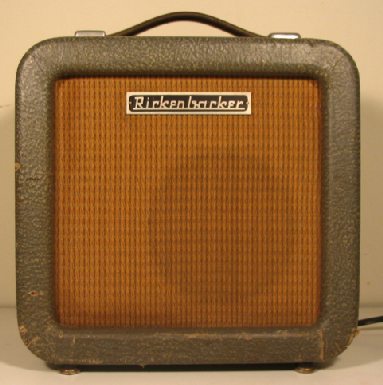
|

|
M-8E
The E stands for "Electro" (see the E12 down). Made in the 1950's, its cabinet was 17½"W x 14½"H x 9"D. The controls featured two instrument inputs, a single Volume/Tone control which acted as an on-off switch, a fuse and a red jewelled light. Jensen Blue Label speaker. The schematic is on the RIC Web site and shows a 5Y3GT rectifier, a 7025 preamp and a 6V6GTA for the power stage.
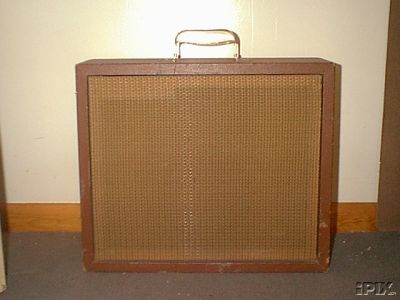
|

|
The original Special Design Jensen on this item had the numbers 220510 (10th week of 1955) and P8-U C6232-5 imprinted on the bottom of the magnet.
M-9
This Unknown 50's M Series on Peter McCormack's Rickenbacker Forum is in fact an M-9 amplifier. The control panel offered two double inputs, two volume knobs, and a tone control (with an "off" feature). Its speaker is a Jensen Special Design.
M-11
The 50's version of the M-11 features one microphone and two instrument inputs with separate volumes knobs and bass-treble control, a 12" Jensen speaker. The case design and the grey Tolex were standard fifties Rick design.
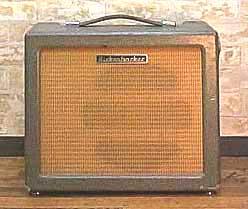
|
But grey's so... dull. What about alligator skin? Yes, someone did it.
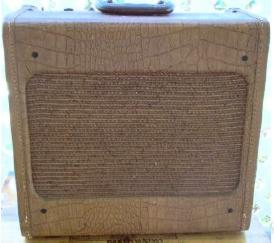
|

|
You can find the schematic on the RIC web site. The M-11A was the same amplifier plus a tremolo.
M-12
See the 1957 catalog. See also Mike Rhodes' Honey Pie for an M-12 in Kalamazoo-ish disguise... but the control panel reveals its Santa Ana origins!
M-14
Pretty rare, this one, and no photo therefore but the B14 is said to be similar. The only samples I've heard of are actually M-14A models (A standing as usual for the tremolo option) which had a 22"W x 19"H x 9"W case with 4 inputs, volume, tremolo speed and depth, and tone controls. The speaker was a 12" Jensen. A foot switch allowed the performer to activate the tremolo while playing on the first channel.
M-15
Most remarkable was the 15" Jensen speaker. Some versions were also seen with a complementary 4" Jensen tweeter, which doesn't appear in the '57 catalog. The cabinet is 22¼"W x 19½"H x 11½"W.
Electronically speaking, there were seven tubes; among them, two 6L6 in push-pull at the power stage, and a 5V4 or a 5AR4 for the rectifier, the latter giving a little more voltage in the B+. The big novelty here was a standby switch. Like most Rickenbacker models, the A suffix meant a vibrato was added.
M-16 Supersonic
Predecessor of the 1960's B-16, here is a superb example of this 40-watter in tweed clothing:

|
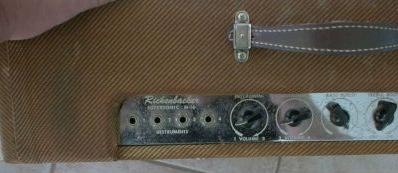
|
These were used by country artist Jim Reeves, here with his Blue Boys in a well-known picture.
Obsolete Electronics seems to have reverse-engineered a schematic.
M-30 Eko-Sound
If the M-8 is a reputed practice/harp amp, the M-30 attains cult status. It was designed around 1955 by Ray Butts (of Gretsch Filtertron pickups fame) who built 68 of them under the name "EchoSonic" for $495 apiece.
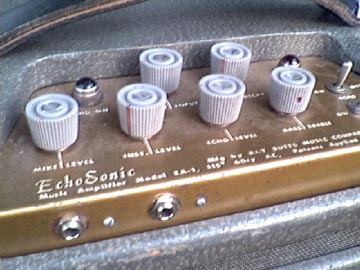
|
The originality of this 21"x21"x9" amp lies in the echo unit which, while embedded in the case, has its own power supply and three controls: level, decay and input. Indeed, the fixed-speed, multi-headed echo was hard-wired for rockabilly. Roy Orbison, Scotty Moore, Carl Perkins and the like were customers before the last one was traded along with the rights to F.C. Hall. Rickenbacker sold small quantities of this amp around 1961, renaming them Eko-Sound. Its lack of commercial success was probably due to a decaying interest in all things rock and roll (then considered a short-lived fad...) at the beginning of the sixties.
There are a few EchoSonic/Eko-Sound in activity today, one of them having been salvaged from a dumpster... You will find the story on Deke Dikerson's site.
E-12
Ahh... the joys of branding. Until 1965, Rickenbacker was just a brand. Electro String and the Radio & Television Equipment Co. were the real names behind the truss rod covers. Others brand names were used as well, in order to reach different markets, like Ace or Academy for student sets in the thirties, Astro for a weird-looking guitar kit in the sixties, Symfonia... So a line of amps and guitars in the 1960s was named Electro. The guitars were budget models: for instance, the E17 was a set-neck 425. They were sold through other channels than the usual Rickenbacker distributors.

|
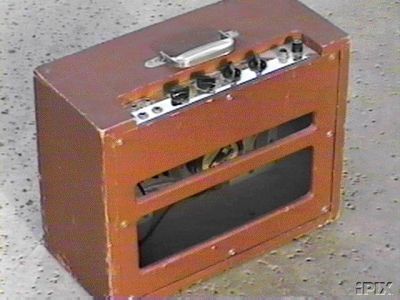
|
The speaker is a 12" Jensen, S/N 220522 (hence 22th week of 65). The amp size is 18"W x 15"H x 8"D and the controls were four inputs, volume, tone and tremolo. This amplifier has a twin brother at Rickenbacker's private "museum", whose speaker S/N is 220533.
B-9A
The first B-Series were mid-sixties amplifiers.
You will find the schematic on RIC's web site. Electronically, it is an M88 plus vibrato in addition to the volume+tone pots, and four inputs, featuring the classic 7025 and 6V6 at the preamp and power stage respectively.
B-14
The amp has a rather large cabinet with grey tolex with grey grill cloth (that
was spray painted grey), one 12" Jensen P12Q speaker, normal channel and
vibrato channel with the original footswitch. The grill cloth appears to be
orignal even though the reverse side of the grill cloth is very similar to
Fender grill cloth except it is brown and gold instead of silver and black
found on Fender amps.
[Tubes:] 3-12AX7's, 2-6V6GT, 1-5Y3GT.
Mickey Edwards

|
B-16 / B-22 Supersonic
These amplifiers were dubbed "silver amps" by John Hall. You can find the B-16 series schematic on RIC's web site. This B-16 looks very much like the B-14 above, only bigger: 24"H x 26"W x 9"D.
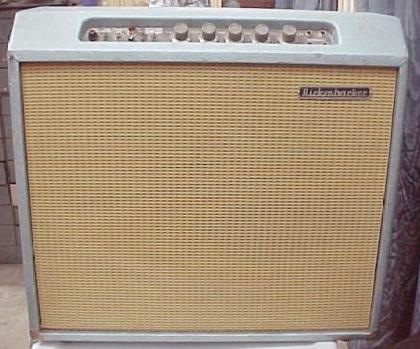
|
On the front panel, controls are: fuse, hum switch (mains inverter?), stand by, 2 lights, on/off, brillante, treble, bass, volume for inputs 3 & 4, volume for input 1 & 2, and the four instrument inputs.
Four 10" Jensen speakers are powered by the usual couple of 6L6s in push-pull, driven by a 12AU7, and the preamp has the three mandatory 12AX7s. The design of the B-16 is very similar to the M-16's, but the component values differ and the plate voltage is increased on the B-16.

|
And here is a nice example of a B-22, seemingly the stack version of the B-16.
Why the silver amps denomination? They might have been covered in a peculiar Tolex like the one pictured above, which looks shiny.
B-410 / B-212 / B-115
Around 73, Paul Taibo and John Hall designed an amplifier based on the 60's Supersonics, only more powerful. The preamp featured three 12AX7, one 12AU7A and one 12AT7 for the reverb and the driver, with a solid-state rectifier, and the power amp had four 6L6. The only FET present is used to connect the vibrato/reverb circuit to one of the inputs. The schematic can be found on the RIC site. The B115 was the bass version, with a 15" boomer but without the reverb and vibrato, and the B212 was a 2-12" speakers version. A single head version was avalaible.
Here's my B-410E, by the way. 71cm H x 71cm W x 28cm D. Controls are: on/off light and switch, stand-by light and switch; master; tremolo speed and depth, reverb, bass, mid, treble, volume, brightness switch, inputs; bass, mid, treble, volume, brightness switch and inputs. The knobs are identical to those found on modern Rickenbacker guitars. On the back, there are a pedal jack, a secondary speaker output and a line output. Four 10" Eminence Alnico speakers. Serial number is NS189, which gives June 1974 - RIC's decoder works for seventies and eighties amps as well as guitars.

|
The general design might be the usual Fender Twin knockoff, but the sound obtained is much cleaner and brighter. And this combo means power: 3 on both volumes is enough for rehearsals and gigs, and my band plays loud. So you have too many friends in your neighbourhood? No problem, just turn the volume pots to, say, 5. Whoa there. I suppose it's not louder than your average Marshall, but the incredible headroom makes the difference - the sound cuts in the mix like butter. My guess is these speakers are really important in the sound chain.

|
On the other hand, the preamp distortion is useless, the reverb is a tad light, and there is no fluidity: don't try to plug in a Les Paul for heavy riffage, à la Slash. This is a specialized amplifier, detailing each and every nuance of your playing. It won't forbid anything... in the grand tradition of Rickenbacker instruments.
This site is in no way associated with Rickenbacker International Corporation. Rickenbacker®, RIC, and logos are trademarks of Rickenbacker International Corp.